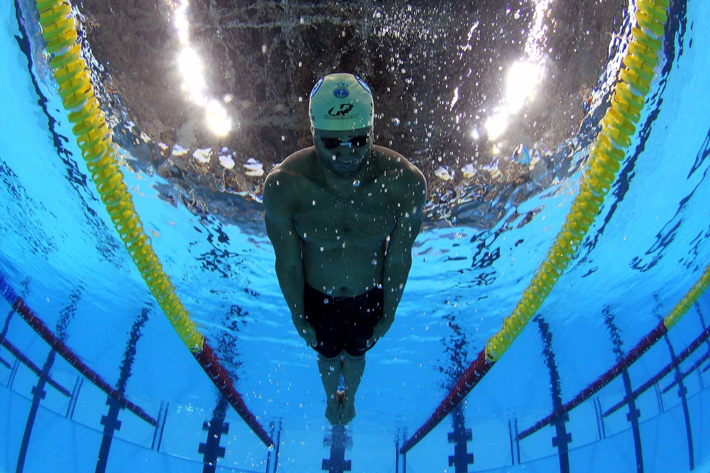Como a transição da natação subaquática para a natação de superfície deve ser realizada por nadadores competitivos?

Downloads
Palavras-chave:
Cinemática, Coordenação Entre Membros, Desempenho, Transformação Linear DiretaResumo
Apesar da crescente importância da fase subaquática de saídas e viradas na competição e da sua influência positiva na subsequente natação de superfície, não há evidências sobre como deve ser realizada a transição da natação subaquática para a de superfície. Portanto, o objetivo do presente estudo foi examinar o papel dos parâmetros segmentais, cinemáticos e coordenativos na velocidade de nado durante as fases de pré-transição e transição. Um total de 30 nadadores nacionais do sexo masculino realizaram 4 × 25 m (uma em cada braçada) a partir de um push start em velocidade máxima enquanto foram registrados em vista lateral por duas câmeras sequenciais (50 Hz), e seus parâmetros cinemáticos e coordenativos de natação foram calculados por meio de algoritmos bidimensionais de transformação linear direta (DLT). Ao contrário da pré-transição, a análise de regressão para trás da transição previu significativamente a velocidade de natação em todos os nados, exceto nado peito (R2 variando de 0,263 no nado crawl a 0,364 no nado borboleta). A coordenação intermembros foi preditora no nado borboleta (p = 0,006), enquanto a profundidade e inclinação do corpo foram preditores nos nados alternados (crawl (p = 0,05) e nado costas (p = 0,04)). Estes resultados sugerem que a posição do corpo e os parâmetros coordenativos da natação (além da frequência e comprimento das batidas de perna ou braçada) têm uma influência importante no desempenho da transição, que depende dos nados.
Referências
(1) Veiga S, Cala A, Mallo J, Navarro E. A new procedure for race analysis in swimming based on individual distance measurements. Journal of Sports Sciences. 2012 Sep 18;31(2):159–65.
(2) Veiga S, Roig A. Effect of the starting and turning performances on the subsequent swimming parameters of elite swimmers. Sports Biomechanics. 2016 May 31;16(1):34–44.
(3) Veiga S, Roig A, Gómez-Ruano MA. Do faster swimmers spend longer underwater than slower swimmers at World Championships? European Journal of Sport Science. 2016 Mar;16(8):919–26.
(4) Nicolas G, Bideau B. A kinematic and dynamic comparison of surface and underwater displacement in high level monofin swimming. Human Movement Science. 2009 Aug;28(4):480–93.
(5) Takeda T, Sakai S, Takagi H. Underwater flutter kicking causes deceleration in start and turn segments of front crawl. Sports Biomechanics. 2020 Apr 27;21(10):1224–33.
(6) Naemi R, Easson WJ, Sanders RH. Hydrodynamic glide efficiency in swimming. Journal of Science and Medicine in Sport. 2010 Jul;13(4):444–51.
(7) Kolmogorov SV, Duplishcheva OA. Active drag, useful mechanical power output and hydrodynamic force coefficient in different swimming strokes at maximal velocity. Journal of Biomechanics. 1992 Mar;25(3):311–8.
(8) Vennell R, Pease D, Wilson B. Wave drag on human swimmers. Journal of Biomechanics [Internet]. 2006 Jan;39(4):664–71. Available from: https://ftvs.cuni.cz/FTVS-2339-version1-wave_drag_on_human_swimmers.pdf
(9) Chollet, Chalies, Chatard. A New Index of Coordination for the Crawl: Description and Usefulness. International Journal of Sports Medicine. 2000 Jan;21(1):54–9.
(10) Schnitzler C, Seifert L, Alberty M, Chollet D. Hip Velocity and Arm Coordination in Front Crawl Swimming. International Journal of Sports Medicine. 2010 Nov 11;31(12):875–81.
(11) Seifert L. World book of swimming : from science to performance. Hauppauge, N.Y.: Nova Science; 2011.
(12) Seifert L, Boulesteix L, Chollet D. Effect of Gender on the Adaptation of Arm Coordination in Front Crawl. International Journal of Sports Medicine. 2004 Apr;25(3):217–23.
(13) Schnitzler C, Brazier T, Button C, Seifert L, Chollet D. Effect of Velocity and Added Resistance on Selected Coordination and Force Parameters in Front Crawl. Journal of Strength and Conditioning Research. 2011 Oct;25(10):2681–90.
(14) Kjendlie PL, Stallman RK, Stray-Gundersen J. Passive and active floating torque during swimming. European Journal of Applied Physiology. 2004 Jun 23;93(1-2):75–81.
(15) Houel N, Elipot M, André F, Hellard P. Influence of Angles of Attack, Frequency and Kick Amplitude on Swimmer’s Horizontal Velocity During Underwater Phase of a Grab Start. Journal of Applied Biomechanics. 2013 Feb;29(1):49–54.
(16) Kjendlie PL, Ingjer F, Stallman RK, Stray-Gundersen J. Factors affecting swimming economy in children and adults. European Journal of Applied Physiology. 2004 Jul 8;93(1-2):65–74.
(17) Xin-Feng W, Lian-Ze W, Wei-Xing Y, De-Jian L, Xiong S. A new device for estimating active drag in swimming at maximal velocity. Journal of Sports Sciences. 2007 Feb 15;25(4):375–9.
(18) Kolmogorov SV, Rumyantseva OA, Gordon BJ, Cappaert JM. Hydrodynamic Characteristics of Competitive Swimmers of Different Genders and Performance Levels. Journal of Applied Biomechanics. 1997 Feb;13(1):88–97.
(19) Ruschel C, Araujo L, Pereira S, Roesler H. Kinematical analysis of the swimming start: Block, flight and underwater phases. In: Proceedings of the XXV ISBS Symposium, Ouro Preto, Brazil. p. 385–8.
(20) Lyttle A, Blanksby B, Elliott B, Lloyd D. The effect of depth and velocity on drag in the streamlined glide. J. Swim. Res. 1998, 13, 15–22.
(21) Machado, L.; Ribeiro, J.; Costa, L.; Silva, A.J.; Rouboa, A.I.; Mantripragada, N.; Marinho, D.A.; Fernandes, R.; Vilas-Boas, J.P. The effect of depth on the drag force during underwater gliding: A CFD approach. Int. Soc. Biomech. Sport. 2010, 4–5.
(22) Arellano, R.; Pardillo, S.; Gavilán, A. Underwater undulatory swimming: Kinematic characteristics, vortex generation and application during the start, turn and swimming strokes. In Proceedings of the XX International Symposium on Biomechanics in Sports, Cáceres, Spain, 1–5 July 2002.
(23) Arellano, R.; Pardillo, S.; Gavilán, A. Usefulness of the strouhal number in evaluating human underwater undulatory swimming. In Proceedings of the IX Symposium Mondial Biomécanique et Médecine de la Natation, Saint-Etienne, France, 21–23 June 2002; pp. 33–38.
(24) Tor E, Pease DL, Ball KA. Comparing three underwater trajectories of the swimming start. Journal of Science and Medicine in Sport. 2015 Nov;18(6):725–9.
(25) De Jesus, K.; de Jesus, K.; Machado, L.; Fernandes, R.J.; Vilas-Boas, J.P. Linear kinematics of the underwater undulatory swimming phase performed after two backstroke starting techniques. In Proceedings of the 30th International Conference on Biomechanics in Sports, Melbourne, Australia, 2–6 July 2012; pp. 371–374.
(26) World Medical Association. World Medical Association Declaration of Helsinki. Ethical principles for medical research involving human subjects. Bull. World Health Organ. 2001; 79, 373–374.
(27) Lyttle, A.; Blanksby, B. A look at gliding and underwater kicking in the swim turn. In Proceedings of the 18th International Symposium on Biomechanics in Sports, Hong Kong, China, 25–30 June 2000.
(28) Abdel-Aziz, Y.I.; Karara, H.M. Direct linear transformation from comparator coordinates into space coordinates in close range photogrammetry. In Proceedings of the Symposium on Close Range Photogrammetry, Urbana, IL, USA, 26–29 January 1971; pp. 1–18.
(29) Takeda T, Takagi H, Tsubakimoto S. Effect of inclination and position of new swimming starting block’s back plate on track-start performance. Sports Biomechanics. 2012 Sep;11(3):370–81.
(30) Atkison RR, Dickey JP, Dragunas A, Nolte V. Importance of sagittal kick symmetry for underwater dolphin kick performance. Human Movement Science. 2014 Feb;33:298–311.
(31) Barbosa TM, Kelly de Jesus, J. Arturo Abraldes, Ribeiro J, Figueiredo P, João Paulo Vilas-Boas, et al. Effects of Protocol Step Length on Biomechanical Measures in Swimming. International Journal of Sports Physiology and Performance. 2015 Mar 1;10(2):211–8.
(32) K Davids, Bennett S, Newell KM. Movement system variability. Champaign, Il: Human Kinetics; 2005.
(33) HOPKINS WG, MARSHALL SW, BATTERHAM AM, HANIN J. Progressive Statistics for Studies in Sports Medicine and Exercise Science. Medicine & Science in Sports & Exercise [Internet]. 2009 Jan;41(1):3–13. Available from: https://www.ugr.es/~fmocan/MATERIALES%20DOCTORADO
(34) Nakashima M. Simulation Analysis of the Effect of Trunk Undulation on Swimming Performance in Underwater Dolphin Kick of Human. Journal of Biomechanical Science and Engineering. 2009;4(1):94–104.
(35) Hochstein, S.; Blickhan, R. Body movement distribution with respect to swimmer’s glide position in human underwater undulatory swimming. Hum. Mov. Sci. 2014, 38, 305–318.
(36) Alves, F.; Lopes, P.; Veloso, A.; Martins-Silva, A. Influence of body position on dolphin kick kinematics. In Proceedings of the 24th International Symposium on Biomechanics in Sports, Salzburg, Austria, 14–18 July 2006; pp. 3–6.
(37) Toussaint HM, de Groot G, Savelberg HHCM, Vervoorn K, Hollander AP, van Ingen Schenau GJ. Active drag related to velocity in male and female swimmers. Journal of Biomechanics. 1988 Jan;21(5):435–8.
(38) Suito H, Ikegami Y, Nunome H, Sano S, Shinkai H, Tsujimoto N. The Effect of Fatigue on the Underwater Arm Stroke Motion in the 100-m Front Crawl. Journal of Applied Biomechanics. 2008 Nov;24(4):316–24.
(39) Wakayoshi K, D’Acquisto L, Cappaert J, Troup J. Relationship Between Oxygen Uptake, Stroke Rate and Swimming Velocity in Competitive Swimming. International Journal of Sports Medicine. 1995 Jan;16(01):19–23.
(40) Seifert L, Chollet D, Bardy B. Effect of swimming velocity on arm coordination in the front crawl: a dynamic analysis. Journal of Sports Sciences. 2004 Jul;22(7):651–60.
(41) Barbosa TM, Keskinen KL, Fernandes R, Colaço P, Carmo C, Vilas-Boas JP. Relationships Between Energetic, Stroke Determinants, and Velocity in Butterfly. International Journal of Sports Medicine. 2005 Dec;26(10):841–6.
(42) Strzala M, Krezalek P. The Body Angle of Attack in Front Crawl Performance in Young Swimmers. Human Movement. 2010 Jan 1;11(1).
(43) Anderson, E.J.; McGillis, W.R.; Grosenbaugh, M.A. The boundary layer of swimming fish. J. Exp. Biol. 2001, 204, 81–102.
(44) Seifert L, Chollet D, Allard P. Arm coordination symmetry and breathing effect in front crawl. Human Movement Science. 2005 Apr;24(2):234–56.
(45) Seifert L, Leblanc H, Chollet D, Delignières D. Inter-limb coordination in swimming: Effect of speed and skill level. Human Movement Science. 2010 Feb;29(1):103–13.
(46) Seifert L, Vantorre J, Chollet D. Biomechanical Analysis of the Breaststroke Start. International Journal of Sports Medicine. 2007 Nov;28(11):970–6.
(47) Sanders RH, Cappaert JM, Devlin RK. Wave characteristics of butterfly swimming. Journal of Biomechanics. 1995 Jan;28(1):9–16.
(48) Sanders RH, Cappaert JM, Pease DL. Wave Characteristics of Olympic Breaststroke Swimmers. Journal of Applied Biomechanics. 1998 Feb;14(1):40–51.
NOTAS
Artigo adaptado e traduzido para o português pelos editores de NADAR! SWIMMING MAGAZINE para republicação, conforme normas de submissão do periódico. Versão original em: https://www.mdpi.com/1660-4601/19/9/4938 LICENÇA ORIGINAL E DA ADAPTAÇÃO: https://creativecommons.org/licenses/by/4.0/.
Publicado
Como Citar
Edição
Seção
ARK
Licença
Copyright (c) 2023 Jelena Stosic, Santiago Veiga, Alfonso Trinidad, Enrique Navarro

Este trabalho está licenciado sob uma licença Creative Commons Attribution 4.0 International License.






